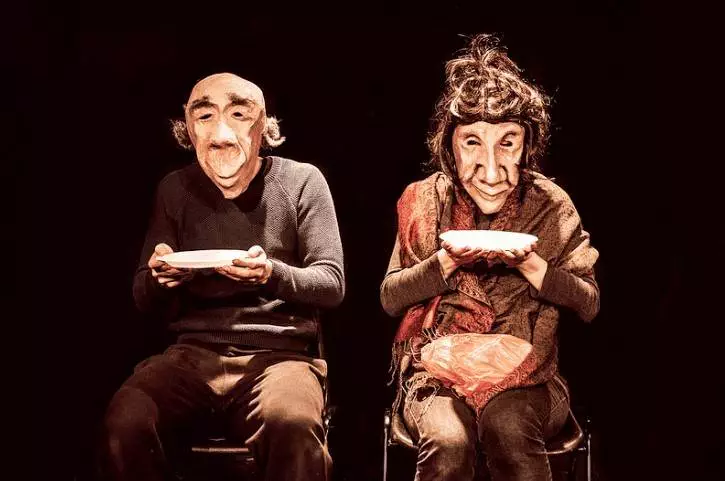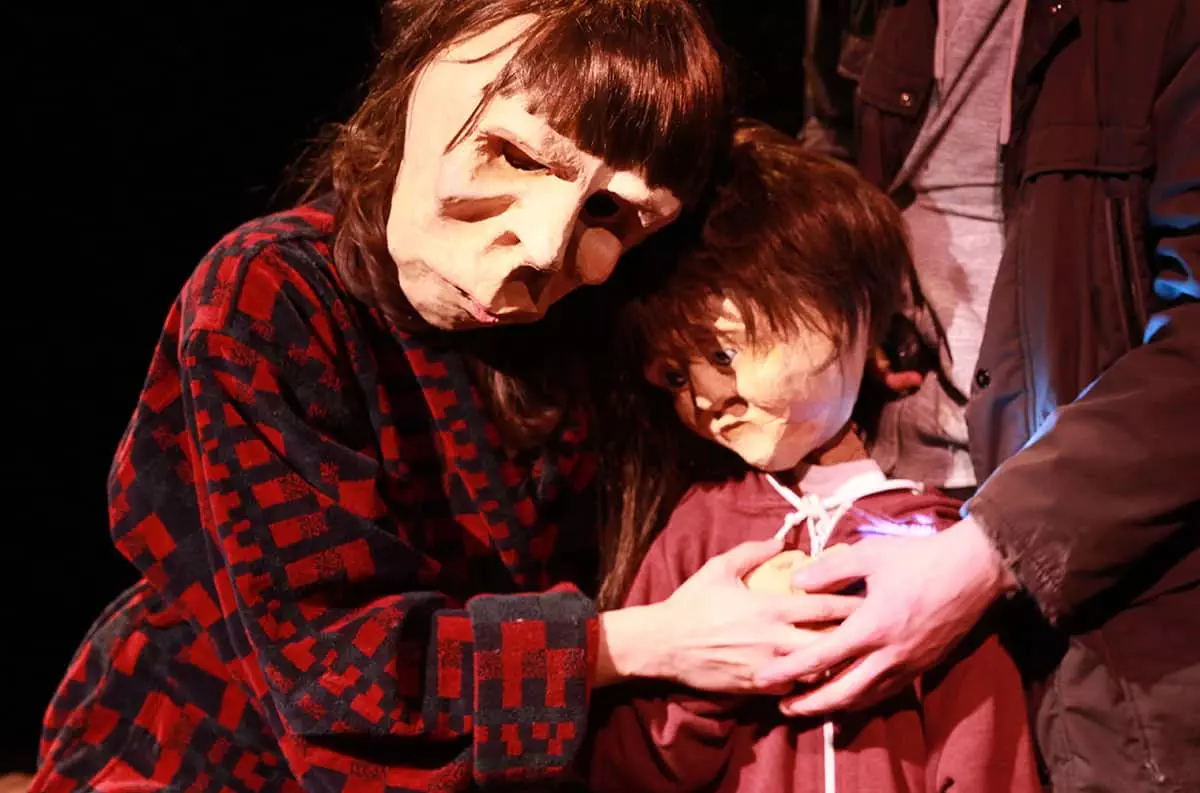
One of the advantages of seeing a play in a small theatre like Slung Low is that after the curtain has come down, well there isn’t actually a curtain at Slung Low, but it’s a standard theatrical phrase, if you’re not fluent I mean at the end of the show, you sometimes get an opportunity to chat to the cast and crew. The end of The Marked provided one of those opportunities. Not only did I get to meet the cast, but I was also introduced to the puppets and the masks. Quite the little social gathering it was. But there was a serious intent to why I decided that I needed to speak to the cast. I knew as I was watching The Marked that I was feeling something, but I couldn’t quite put my finger on what. I wanted someone from the cast to tell me what they wanted me to feel, but they wouldn’t or couldn’t. ‘Sometimes.’ said Dorie Kinnear, ‘it is enough to just feel, you don’t need to define it’.
I had read the promotional leaflet about The Marked and was not quite sure what to expect. I was looking forward to seeing the puppets and was impressed that all of them from the pigeon to the little boy moved in a natural way. It’s surprising how easy it is to stop seeing the puppeteer. It brought to mind the National Theatre production, War Horse. Indeed, one of the actors who performed in a previous Theatre Temoin production of The Marked is now working on War Horse.
The papier-Mache masks have fixed expressions, so giving them character beyond the grotesque, you would think is a bit of a challenge, but it is surprising how the gestures of the actors can transform the mask of an old hag in to that of an endearing grandmother.
Like most of the productions at Slung Low the cast of The Marked is small, but the innovative stage design, puppets, and masks create the illusion that the cast is much bigger than the curtain call confirms.
Our hero is a young man called Jack. He has grown up in less than ideal circumstances. He seems to have slipped through the net of so many of those services that are supposed to help him or perhaps it is that they can only do so much. The net result is that Jack is existing on the fringes of society where what most people call deprivation is just normal life. It is only when Jack sees himself in the life that someone else is living that we see him start to take the steps that will improve his life. Before that process can start Jack also has to deal with the demons that infect his daily life.
Homeless people, especially young homeless people like Jack are people that are on the periphery of my life, I know they are there because I walk past them. They live a life that I have no experience of, but statistics say that many of us are just a couple of missed rent payments away from being homeless. Having a home is a requirement in our society, and owning your own home is a mark of success. Nothing makes you more popular than being successful, so perhaps that is why the homeless get such a bad press, after all they have failed in our society.
That failure is defined by the stereotypical homeless person, usually male, scruffy, unshaven, multiple layers of clothing, a piece of string for a belt and all their belongings carried in a ruck sack. Oh, and we must not forget that they are addicted to either alcohol or drugs or more likely both. Is the cause of their homelessness the addiction or is the addiction a more likely consequence of their situation?
Addiction is just one of the reasons for homelessness, there are unfortunately many others.
The realism of The Marked is the direct result of the contribution made to the development of the piece by people who have and who are experiencing homelessness and the people who support them.
There are doubtless homeless people who could with hindsight say with some certainty that if only they had, or if only they had not then they would not be homeless. Unfortunately for people like Jack, the young homeless, homelessness is one of the potential outcomes of being part of a dysfunctional family, part of the care system that at the end has failed them.
The Marked gives us a window into understanding the reasons why Jack is homelessness and why other people may be homeless. It is the start of the humanising the homeless person. From understanding the reasons it is perhaps a major step to passing the time of day with someone who is homeless. But, that is how many people who support the homeless community by volunteering on out-reach projects or in shelters start their involvement with the community.
As with many aspects of modern life the perception seems to be that if we throw enough money at the problem or the person affected then it will go away. If you pay your taxes and give some money you can walk on by. But, money needs to be directed at support services like St George’s Crypt not the individual.
It has taken a few days, and I still might not quite understand what I am supposed to feel after seeing The Marked, but I do know that I have seen a piece of theatre that has with a small cast and probably an even smaller budget created a powerful interpretation of a way of living that I have no experience of, and which through good fortune I hope I can avoid being part of. But it has made me aware in a way that no news report or TV documentary ever could that homelessness only dehumanises because of the way in which we, who are not homeless decide to view the nameless individuals we see without feeling. Perhaps that is what The Marked offers me, the opportunity to simply feel the pain that another human being is living.
